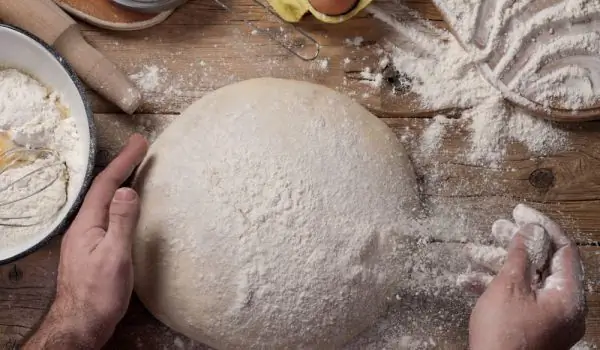2025 Author: Jasmine Walkman | [email protected]. Last modified: 2025-01-23 10:18
A variety of breads and pies are made around the world. The most common dough from which they are prepared is this with yeast for bread. The most popular plain bread is kneaded only from flour, water, yeast and salt. And this is because no other leavening agent can make the dough increase in volume as much as bread yeast.
Yeast dough is divided into two types - usually (mentioned above) and enriched with some additive (eggs, fat, milk and others).
There are two types of yeast - fresh and dry. Fresh yeast must have a pleasant and fresh aroma, not stick and be easily crushed. The traditional way is to dissolve it in a little water or milk - if you add a little sugar, you will speed up its foaming. The liquid should be warm (from 25-35 degrees_ - this is the optimal temperature for the life of the yeast in the yeast. At 55 degrees the yeast dies, and at 10 degrees - are not activated.
Therefore, there is a requirement for the yeast dough to be kneaded and fermented in the heat. Dry yeast has a longer shelf life and does not need to be dissolved in a liquid unless the recipe requires it.
Yeast dough can be prepared in two ways - single-phase and two-phase
In the single-phase way, all the products provided in the recipe are mixed at the same time, ie the yeast, salt, sugar and the rest of the liquid dissolved in a little of the provided liquid are added to the sifted flour. Knead the dough until it starts to bubble. It is formed into a ball, placed in an oiled bowl, sprinkled with flour so as not to form a crust. Cover with a towel and leave to rise in the heat until it doubles in volume. Mix, shape in the desired way and leave to rest for another 10-20 minutes, then bake.

In the two-phase method, first prepare a thin paste of yeast, a little flour and more than half of the liquid provided in the recipe. Sprinkle the porridge with flour, cover with a towel and leave to rise in the heat for about 20 minutes. The porridge is made in a larger vessel because it increases its volume three times. Make a well in the rest of the flour, pour in the foamy porridge, the other products provided in the recipe, and knead until bubbles appear.
Form the dough into a ball, place in a greased bowl, sprinkle with flour so as not to form a crust. Cover with a towel and leave to rise in the heat until it doubles in volume. Mix, shape in the desired way and leave to rest for another 10-20 minutes, then bake.
Remember that well-risen dough is easier to bake than poorly risen. Take your time - good bread requires not only quality flour and yeast, but also time and heat.
Recommended:
Bread Yeast Or Natural Yeast?

There is hardly anyone who does not like the smell of freshly baked bread. And most of us know that we can't make bread if we don't use bread yeast or so-called natural sourdough to make it. Both products have the same effect, but are actually radically different in composition.
In The Absence Of Yeast And Baking Soda: Make Yeast For Bread

In Bulgaria the yeast was traditional natural yeast used in kneading bread. For to make yeast for bread , one of the most important factors in making it is patience. It is fed once every 24 hours. If you stick to a healthy and quality lifestyle, make bread yeast.
Specifics Of Kneading Einkorn Dough

Einkorn is an ancient cereal. All other varieties of wheat that we know today come from it. Until recently, einkorn was considered an obsolete cereal, but in recent years it has undergone rehabilitation. The nutritional value of einkorn is much higher than wheat.
Add These Two Ingredients To The Dough And You Will Make The Perfect Pancakes

A group of American chemists have found that by adding only two ingredients to the standard pancake batter you will get the perfect breakfast. In addition to flour, milk and eggs you need to add lemon juice and butter. Scientists also claim that the most common mistake of the hosts is to knead the dough for too long, because that way it becomes tough and the pancakes are not so appetizing.
Types Of Dough And Basic Kneading Techniques

The dough is a homogeneous mixture of flour with a little water. Enhancers such as salt, sugar, leavening agents, eggs, milk and dairy products, fats and others can be added to this mixture. There are different types of dough: bread, steamed, Easter cake, puff pastry, butter (puff pastry), biscuit, crumbly (sandy), cereals (potatoes, cassava, etc.

